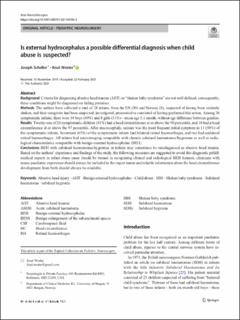| dc.description.abstract | Background: Criteria for diagnosing abusive head trauma (AHT) or “shaken baby syndrome” are not well defined; consequently, these conditions might be diagnosed on failing premises.
Methods: The authors have collected a total of 28 infants, from the US (20) and Norway (8), suspected of having been violently shaken, and their caregivers had been suspected, investigated, prosecuted or convicted of having performed this action. Among 26 symptomatic infants, there were 18 boys (69%) and 8 girls (31%)—mean age 5.1 month, without age difference between genders.
Results: Twenty-one of 26 symptomatic children (81%) had a head circumference at or above the 90 percentile, and 18 had a head circumference at or above the 97 percentile. After macrocephaly, seizure was the most frequent initial symptom in 13 (50%) of the symptomatic infants. Seventeen (65%) of the symptomatic infants had bilateral retinal haemorrhages, and two had unilateral retinal haemorrhages. All infants had neuroimaging compatible with chronic subdural haematomas/hygromas as well as radiological characteristics compatible with benign external hydrocephalus (BEH).
Conclusions: BEH with subdural haematomas/hygromas in infants may sometimes be misdiagnosed as abusive head trauma. Based on the authors’ experience and findings of the study, the following measures are suggested to avoid this diagnostic pitfall: medical experts in infant abuse cases should be trained in recognising clinical and radiological BEH features, clinicians with neuro-paediatric experience should always be included in the expert teams and reliable information about the head circumference development from birth should always be available. | en_US |

